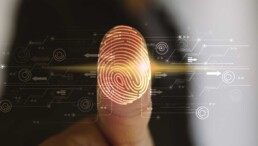Biometrics a necessity in modern security
For data center security, businesses need to implement the best possible strategies, not just for compliance reasons but to ensure the safety of data as this resources grows in both value and importance. According to the Boston Business Journal, modern efforts in building access control have to include biometrics to ensure complete protection.
Corporate security means are evolving at a promising pace, which is important because so are the capabilities of criminals seeking illegal and unauthorized access to firms’ data. The value of data continues to rise as enterprises focus on new ways to leverage information for profits and drive enterprise growth through it. This makes it more appealing and lucrative for criminals to acquire it by whatever means they can. Cybersecurity was the buzzword of the 2000s, but during this decade data thieves have started to bypass firewalls altogether by turning towards more antiquated methods to gain direct access to what they want.
In the 1900s, a criminal could assume a fake identity and gain access to nearly anywhere if he or she was clever enough. A focus on security over the last 100 years has made this much more difficult, and finally, with the migration to computers, companies could keep a thief from getting his or her hands on information by storing it digitally. The criminals adapted and hacking become the new breaking and entering of corporate espionage. However, rather than try to keep up with these technologies, spies and opportunists have decided to take a step backward and returned to social engineering to get what they want. Now faking a name badge or ID card and knowing your way around an IT service desk can gain someone access to a server rack that he or she shouldn’t have, and all those expensive, digital security methods are useless to stop them.
By investing in high-quality biometrics technology, companies can protect their most important asset from both ends, eliminating unauthorized access to server rooms and optimizing the protection of their data for the criminals of the 21st century. This method of ensuring data center security will be essential , and making the right investment into scalable, high-quality biometrics will help a firm adapt as needed over time to ensure continued protection.
Related Articles
Nothing found.
Researchers working to replace passwords with biometric security
While many businesses are investing in biometric technology for their data centers and building access needs, the technology is just starting to see widespread adoption in consumer markets. Driven by the mobile industry, the use of biometric security is just starting to grow, and researchers at Purdue University are looking to take it to the next level.
According to the St. Louis Post-Dispatch, researchers at Purdue University’s International Center for Biometrics Research are exploring a broad expansion of biometric technology to replace the everyday user password, simplifying computing experiences and improving security for sensitive information.
“I think the average person would tell you they have too many passwords and it’s a hassle to change them all the time, and therefore they use the same password for lots of things, which inherently makes that easier to break,” Stephen Elliott, director of the center, told the news source.
While the technology will not likely be ready for widespread consumer adoption any time soon, its application in specific fields is already showing promise. The military utilizes biometrics to secure sensitive information, while many businesses use fingerprint scanners for access control and security measures.
The growth of biometrics into consumers markets will also spell positive news for enterprises deploying these strategies to protect their data centers and facilities. Continued growth of the market will drive innovation and new technologies will develop from the results that could boost security, the quality of access control systems and more. Firms will need to maintain high-quality systems and services, while investing in scalable solutions that will grow with their operational demand over time.
Biometrics offers high-end security for any industry. Investing in the right tool will help companies optimize access to any building, room or server cabinet over any key-based entry system.
Related Articles
Nothing found.
Data center security top concern with cloud migration, consolidation
Some experts are heralding cloud migration and data center consolidation as the wave of the future for data center technologies and needs. However, the overwhelming concern regarding this move across the globe is security compliance.
According to SafeNet’s recent research report “Encryption, Key Management And Consolidation in Today’s Data Center,” nearly three-quarters of IT professionals consider center consolidation to be an important step in the future of their operations. However, more than half don’t have a strategy in place to accomplish such goals, and only 25 percent have actually completed any consolidation-focused projects to date.
The main concern holding decision makers back from developing cloud migration and consolidation strategies is security. Strong management practices and physical center worries have firms waiting to deploy a solution and start investing in cloud computing. The study found that, even currently, less than 10 percent of businesses use hardware-based security features for their data centers, and while encryption was an oft-cited issue, the lack of physical data center security could prove to be the true fatal flaw.
Optimizing security through deployment of biometric technology can help companies optimize the protection of their data whether driving cloud adoption or not. Biometric security offers the last critical level of protection that businesses need to have to ensure their data is completely safe from theft and other risks, especially when considering center consolidation.
Data center colocation is one way that many firms reduce costs without affecting the efficiency of their center operations. These efforts outline the need for high-quality biometrics clearly, demonstrating how adding that final layer of physical security can ensure the integrity of data protection without having an impact on the workflow of center engineers and maintenance.
A firm’s decision to invest in center consolidation or cloud solutions shouldn’t have to hinge on security practices. With the right technology in place, businesses can eliminate threats on the software and hardware sides of data protection, while streamlining accessibility for their data center staff. Fingerprint scanner hardware puts security in the palm of a company’s hand, it’s simply a matter of how to develop those strategies into a foolproof plan that supports the scalability and growth of data center operations at the same time. Biometrics can do that and more, with the right investment.
Related Articles
Nothing found.
More firms turning toward colocation for affordable disaster recovery
Colocation seems to becoming a more popular way for companies to avoid high costs related to disaster recovery and preparedness. However, as more firms turn to colocation centers to protect their data, they need to consider their data center security needs as well.
According to CBR Online, cost efficient disaster recovery solutions are becoming a top priority for most companies, especially small businesses, to the detriment of data center capabilities in some cases. In fact, some firms are sacrificing reliability for cost, a situation no company should risk.
“DR is going through some changes – a lot of users are moving from a gold standard to a more cost efficient model where they know there may be a slightly increased failure but they are able to save substantial costs,” Rakesh Kumar, VP of research at Gartner, noted about the trend.
In order to avoid sacrificing security, reliability or cost, businesses should consider investing in dedicated server rack security within their colocation strategy. By deploying biometric technology, companies can protect their data better than ever and still benefit from the savings of a colocation data center.
In a recent guide to selecting the right colocation provider, TechTarget included customization as a key consideration for businesses.
“While colocation data centers are set up as lights-out operations, customers still can be on-site to manage their systems when needed,” the news source noted. “It’s one way that colocation differs from cloud hosting. If the colocation company meets these requirements, compare its managed services, specialization and other factors to choose your partner.”
Any firm concerned with the security of their colocation-based servers that wants to optimize both disaster recovery and reliable protection should ensure they are investing in a provider that allows for on-site management customization to include biometric security measures. As such, a business can eliminate the risk of another firm the provider services accessing its data, or other forms of unauthorized access. While colocation centers are necessarily less secure than other options, this also offers peace of mind.
Colocation is a key opportunity for businesses, especially SMBs, to keep their data center costs down without sacrificing quality, reliability or security. Firms need to ensure they aren’t putting their own operations at risk by not taking advantages of these opportunities. The right partnership could help companies optimize their workflow, data protection and IT budget.
Related Articles
Nothing found.
Biometric technology growth highly anticipated for business security
While the optimization of data security and management becomes a higher priority for businesses, more companies are turning toward biometric technology to meet their needs. According to a recent study by Gartner, 30 percent of organizations are expected to invest biometric authentication solutions by 2016. While the study focused on mobility and BYOD trends, this represents the larger drive toward biometric security in general.
“Security leaders must manage users’ expectations and take into account the user experience without comprising security,” said Ant Allan, vice president of research at Gartner. “Adopting significantly different authentication methods for different devices will eventually be unsustainable.”
Currently, only five percent of enterprises are utilizing biometric authentication protocols for their mobility strategies. A 25 percent increase in adoption over the next two years would be unprecedented in new technology growth. The key reason for advanced deployment of these tools, the report noted, was user experience and expectations, and biometric solutions’ ability to properly manage both without compromising security.
More data center operators are investing in biometric solutions as well. According to findBiometrics, these solutions are being deployed to optimize the protection of highly sensitive data in the health care, financial and condominium markets. One industry expert told the news source that the continued adoption of such data center security options is already at a record pace, with critical infrastructure improvements being optimized by identity and authorization management that truly protects from unauthorized access.
The primary benefit that all early adopters of biometric access control solutions are realizing is the option to rely on “true identity” access. The actual person is responsible for entry, rather than an ID card, key or passcode that can be forged or illicitly gained. This leads the reasons for adoption, but scalability and resiliency are other top ROI drivers.
With biometrics, businesses and data center management professionals can streamline their workflows around security compliance that is reliable and trustworthy, rather than remaining wary of their authorization capabilities. In the end, all firms can benefit from advanced security measures, like biometrics, and see their data protection strategies emboldened by such initiatives.
Data security and protection relies on trust and reliability, and only biometrics provides both through a reasonable and sustainable process that keeps access to server racks easy and productive.
Related Articles
Nothing found.
Access control management set to evolve in 2014
The new year brings new opportunities for businesses and data center operators to improve their access control management. According to Help Net Security, several trends are set to take off in 2014 in the ID and access management field, having an impact on how firms optimize data center security operations.
“We believe that the technology trends of cloud, mobile and social will continue to heavily influence the direction and need for IAM in 2014, but we also see new business demands and enabling technologies joining in to put a twist on the IAM and security path for many organizations,” Mike Denning, senior vice president and general manager for CA Technologies’ security business, told the news source.
Of course, trends like cloud computing, mobility and the software-defined data center are having an impact on how businesses control and manage their data, but when it comes to actual building access control, there are important implications to consider as well. As companies invest more in the cloud, how do they know their security options are optimized? Will mobile accessibility affect data security? Will the software-defined data center change how companies manage their physical servers? These questions will need to be considered and addressed as the year progresses.
Optimizing access control management beyond these factors will require new solutions to keep up with the accompanying trends. To this end, many enterprises may want to consider biometric technology. Biometric authentication in the form of fingerprint scanners and the like will establish a standardization of security protocols that modern data centers need. Paired with a scalable, flexible access control system, these technologies will ensure streamlined operations without reducing security, as authorized personnel will still have quick and easy access to whatever they need while the building, server rack or room is effectively locked down to other entry.
As the consumerization of IT spreads this more personalized form of security is also helpful is providing peace of mind to businesses and data center staff. Biometric security options are becoming better understood and more commonplace, making people more comfortable with the technology, and while security is still a major issue to contend with, simplifying the approach to it can help streamline success.
Access control management may be evolving, but that doesn’t mean businesses have to scramble to keep up with the necessary changes.
Related Articles
Nothing found.
Biometric security relies on context
Context is a critical component of optimizing biometric security for building and server room access. Without context, businesses won’t be able to properly manage access control, easily update authorization lists or update their security measures when needed. Furthermore, evolving biometric technology use in the consumer market is affecting the context of its use in building access and data center security. For businesses not currently utilizing biometric security, there are many benefits. Faster, more efficient control of who can and can’t access facilities or specific rooms, as well as more fine tuned access control for server rack security, can help firms optimize their total data protection capabilities without limiting the workflow of engineers and server maintenance personnel. At the same time, these technologies can provide peace of mind in an overarching sense as firms look to boost their control over who exactly has access to one of their most vital resources.
When it comes to data center security, the context of biometric technologies may go beyond what most companies realize. Authentication and authorization are just the initial steps of this context, which also extends to personnel management and dual security purposes. Firms aren’t just protecting their facilities or servers from unauthorized access, they are creating a closed circuit of security that establishes multiple safeguards against intrusion. Companies can even reverse the protection, requiring biometric pass codes to exit as well as enter a room, effectively locking down potential bypasses.
However, the context of full biometric security also extends beyond the hardware to the management software used to monitor, control, alter and report on security needs and activities. Within the proper context of full building security, this software will be at the same quality level or beyond that of the fingerprint scanners and other biometric tools used to authorize entry. This software will need to be scalable to personnel needs, while maintaining its own internal security to protect from cyber threats.
Optimizing building security is a well-rounded effort. Having the solutions that incorporate all of the necessary functions and features will provide peace of mind and fully-exclusive protection that modern businesses need, whether operating in a closed facility, a colocation solution or another data center option. Optimizing security in such a way that eliminates risk and helps ensure that the workflow needs to engineering and maintenance personnel aren’t interrupted for security’s sake either.
Related Articles
Nothing found.
5 things every firms should look for in data storage security
Data security is one of the top concerns any business needs to deal with, regardless of industry, size or scope. Without high-quality data center security in place, firms could be breaking federal and state laws, putting their customers at risk and hindering their own success rates. However, developing a top quality strategy for security compliance can be tricky, and companies need to ensure several factors are in place to see success.
When it comes down to it, data protection is about limiting access to information, keeping unauthorized persons out while ensuring that access is easy for legitimate personnel. One of the most used strategies to accomplish this is encryption, but encrypted data is still steal-able, and worst yet, slows down processes so that businesses have to take extra time to actually use that information when it is needed. A better way to fully protect data is to secure it at the source, in the server itself.
The key to accomplishing high-quality server rack security is access control. Implementing a successful access control strategy will require several steps, and firms will need to accomplish them in order to ensure their solution meets operational, compliance and reputation needs.
Internal audit
The first thing any business should do when reassess its data security is perform a full audit of its data needs and uses. By having a comprehensive understanding of current operations, an enterprise will know full well how to optimize the flow of information, and in turn know what not to do to slow it down when it comes to security. An analysis of how security solutions will impact business and productivity will assist in selecting the best option, while detecting key weaknesses that are already present in a firm’s security.
Visualize demand
The next step is to take the type to predict ever use scenario the company may encounter. While current operations are key, it is possible that changes may be necessary in the immediate future to keep up with industry demands, company goals or evolutions in technology. Firms need to visualize their data use one, five and even 10 years down the road to ensure the solutions they are investing in will be compatible and scalable.
Ensure the servers meet needs
Another key piece of the puzzle is to upgrade the actual data center technology if needed. For businesses to implement an extensive security solution, then rip out have their servers a year later to switch to a new system could create chaos an a significant potential increase in cost. If server-level technology upgrades will be necessary in the near future a firm might want to consider performing these changes first. However, depending on the data center security solutions selected, this may not be an issue.
Accessibility
The next consideration is how often servers actually need to be physically accessed. If a firm is going to be in and out of the server room all day – server rack security may not be the best choice because it will slow down workflow. Placing security measures at the building level may be more appropriate in these instances. However, it is still important to consider the security demands of the server cabinet. Dual-level protection may also be necessary for some businesses.
Biometrics
Finally, a business needs to select the security solution that meets its needs. Many companies may find that the best option for them is biometric technology. Biometrics provide critical protection at building access, or the server itself, eliminating risk a whatever level a firm needs. This allows for scalability, optimal protection over time and key support of accessibility, as ease of access will never be an issue for authorized parties.
Related Articles
Nothing found.
Biometrics provides significant security boost for financial companies
Businesses in the financial industry see significant pressure to enhance their data center security, with a great deal on the line should customer information be stolen. As such, more firms are investing in biometric technology to optimize the protection of their servers directly.
According to the Fort Mill Times, biometric security solutions may finally get the recognition they deserve in the financial sector, with increased adoption by banks to protect customer and transaction data. A recent study by Javelin Strategy & Research found that the challenge for deploying these solutions will be lesser for organizations in the financial sector than retail – another industry that has attempted to deploy biometric protection methods in the past.
The report noted that the largest hurdle for firms to overcome is consumer distrust of biometric security. However, when deploying biometrics for server rack security and internal uses, companies won’t have to worry about these concerns.
In the data center, the best level of protection is at the server itself. With biometric solutions in place, a business won’t have to worry about unauthorized access to their physical resources, cutting the risk of an intruder planting a KVM switch or other device to provide direct access to a rack, and therefore customer information.
Related Articles
Nothing found.
Include security as a consideration when selecting colocation
Colocation is becoming a much more popular solution for data center needs as businesses look to keep their costs low but the power of their servers and center high. However, when selecting a colocation provider there are many points to consider to ensure a firm is getting exactly what it needs from a data center operator.
“Enterprises choose colo to save total cost of ownership compared to building or buying a data center,” Ian McVey, head of systems integrators at Interxion Holding N.V., a carrier-neutral colocation provider in Europe, recently told TechTarget. “There are power, security, uptime and cost advantages.”
Traditionally, businesses don’t invest in colocation for IT management services, but rather the scalability and building management solutions they provide. From cooling to power demands, simply running a data center can be incredibly demanding, let alone the data and software side of the puzzle.
However, when firms consider the colocation provider, one of their top concerns should be security. With a shared data center space, server rack security will be a key factor in protecting data.
In order to optimize security, firms should invest in biometric technology that eliminates the risk of unauthorized access to their servers. This will optimize access control while helping keep the costs lower, as a firm won’t have to invest in cages or other physical protection solutions that could end up driving the expense of server cabinet security up.
Optimizing accessibility based on biometric security will help companies focus on other key areas with the assurance that their servers are safe in a colocation environment. In turn, companies will save more so they’ll have funds that can be directed toward other key data center needs, such as scalability, server virtualization or other costs.
Related Articles
Nothing found.







